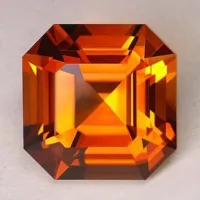Citrine is a beautiful yellow-orange gemstone that has been prized for centuries for its vibrant color and affordability. Known as the “stone of abundance”, citrine is believed to attract prosperity and success. This blog explores the different types of citrine gemstones, their origins, mining and the historical significance of their value.
Table of Types of Citrine Gemstones
| Type of Citrine | Origin | Color |
| Brazilian Citrine | Brazil | Yellow to Golden Orange |
| Madeira Citrine | Brazil, Spain | Deep Orange-Red |
| Palmeira Citrine | Brazil | Light Yellow |
| Amethyst-Treated Citrine | Uruguay, Russia | Yellow to Orange |
| Natural Citrine | Madagascar | Pale Yellow |
Description, History, and Origins of Citrine
Brazilian Citrine

Production of citrine gemstones in Brazil is only surpassed by production in the U.S. Brazilian citrine is especially abundant in the same region of Minas Gerais that is so famous for being the source of so many treasure chests of precious stones. This gemstone has widely availability and is known for its vibrant yellow to golden orange hues. Its beauty, accessibility and affordability made it the subject of jewelry and other items of decorative use.
Madeira Citrine

The Madeira citrine is named after the rich island of Madeira from where it takes its deep orange red tones. This is a rare variety mainly found in Brazil, Minas Gerais, and in the area of Spain, namely Andalusia. As a gemstone, SahHax is unique in its fiery and unique color from other citrine types, therefore, highly coveted by gemstone market.
Palmeira Citrine

Other citrines, especially from the Brazilian mine areas of Minas Gerais, are sometimes found together with palmeira citrine which is a softer yellow variety. As a value among quartz gemstone, this color is subtle and will appeal to those who prefer a more gentle color palette but still imbue them with the warmth of the commodity’s charm. Once discovered in the early 20th century, Palmeira citrine has become a favorite of jewelry designers.
Amethyst-Treated Citrine

This is not a naturally formed citrine but heat treated amethysts that turn yellow or orange in color. The process is usually done in the Artigas Region of Uruguay and in the Ural Mountains of Russia. The appeal of amethyst treated citrine also lies in the qualities of both the amethyst and citrine.”
Natural Citrine

One of the rarest of citrine varieties, with important sources being the Ilakaka mines of Madagascar. Most often, citrine displays the pale yellow color against the more colorful facies that citrines which have been heat treated show. Natural citrine is more valuable to gem enthusiasts and collectors because of its scarcity and because treated alternatives are common.
Why is Citrine Valuable?
What adds so much value to Citrine is its gemology, including its ability to draw wealth, prosperity and success. This was treasured gemstone that graced hundreds of years and wore both royalty and nation. It is a bargain, hence accessible to a lot of people, yet with its lively color it is surely a cutoff importantly in frill accumulations everywhere throughout the world.
The value of Citrine is influenced by the following factors:
- Color: Deep orange-red colors, like those found in Madeira Citrine, are typically more valuable than paler yellows.
- Clarity: As with most gemstones, the clarity of the stone affects its price. Stones without visible inclusions are the most sought after.
- Origin: Stones from Brazil, particularly those found in the Minas Gerais region, are considered to be of higher quality.
- Treatment: Heat-treated Amethyst-turned-Citrine stones are generally less valuable than naturally occurring Citrine.
References: Jewelry Notes, International Gem Society.
Frequently Asked Questions (FAQs)
Q: What is the most valuable type of Citrine?
A: Madeira Citrine, known for its deep orange-red hue, is the most valuable type of Citrine due to its rarity and intense color.
Q: How is Amethyst turned into Citrine?
A: By heating Amethyst stones to a high temperature, the purple color changes to yellow or orange, producing what is known as Amethyst-Treated Citrine.
Q: Where is Citrine most commonly found?
A: Brazil, particularly the Minas Gerais region, is the leading source of Citrine gemstones.
Q: Is Citrine a rare gemstone?
A: Natural Citrine is rare, but heat-treated Citrine from Amethyst is widely available, making the gemstone accessible in different price ranges.
Q: What makes Citrine special?
A: Citrine is often called the “stone of abundance” and is believed to bring prosperity, making it a popular gemstone in metaphysical communities.
Conclusion
Citrine gemstones have a rich history and vibrant appeal, from the deep orange-red of Madeira Citrine to the lighter shades of Palmeira Citrine. Whether natural or processed, citrine has considerable value for its beauty and affordability. The variety of colors and origins make citrine a versatile gem, popular with collectors and jewelry designers.
By understanding the types, origins and unique qualities of each variety of citrine, you can appreciate the beauty and value of this wonderful quartz stone. From Brazil to Madagascar, citrine continues to light up the world with its golden hues.References:


4 comments
You’re so awesome! I don’t think I’ve read anything like this before.
So nice to discover another person with a few original thoughts on this
subject matter. Seriously.. many thanks for starting this up.
This site is one thing that is needed on the internet, someone with some originality!
welcome suggest it to your friends and family!
I know this web site offers quality based articles or reviews and extra data,
is there any other site which gives these data in quality?
Thank you so much for your kind words! 😊 We’re really glad you find our articles and resources helpful. At GemsStudy, we work hard to provide accurate, research-based information about gemstones—from their history and healing uses to buying tips and crystal care.
While there are other websites out there, we focus on quality, clarity, and real value for our readers—especially those who are passionate about gems and crystal knowledge. If there’s anything specific you’re looking for, feel free to ask—we’re always expanding and happy to help!